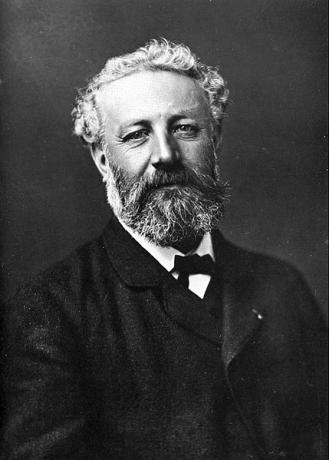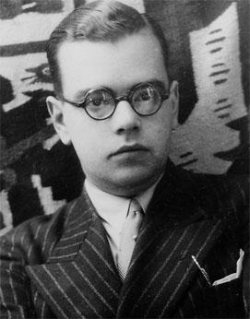Jules Verne was born on February 8, 1828, in Nantes, France. Despite his passion for literature, he was forced, by his lawyer father, to go to law school. However, he did not pursue this profession. In 1863, he published his first best seller: the book five weeks in a balloon.
Considered the science fiction father, the author, who died on March 24, 1905, became famous throughout the world. His books pleased the children's audience and marked generations of young readers (as). Supported by scientific concepts, these works sharpened the imagination of countless people by presenting flying machines, underwater and space travel, as well as other adventures.
Read too: George Orwell – great name in dystopian literature
Jules Verne Biography

Jules Verne (or Jules Verne) was born on February 8, 1828, in Nantes, in the France. In 1837 he and his brother began boarding school at the Saint-Donatien seminary. However, the two tried to flee from there, without success, and were beaten by their father as punishment. In 1841, Verne was transferred to the Petit Seminary and then to the Lycée Royal de Nantes, where he completed his studies in 1844.
At the age of 17, the Verne's interest in the literary career was evident.. However, he did not have the support of his father, a lawyer, who forced him to study law in Paris. However, while studying the law, he frequented the bohemian life of the city and tried to forget his crush on his cousin Caroline, who had married someone else.
Do not stop now... There's more after the advertising ;)
In 1850, he graduated in law, but decided to stay in Paris to pursue a career as a writer. His father, disappointed, decided not to pay for his expenses anymore. The young artist, then, went through difficulties. To survive, he was forced to teach law and write cards for illiterate soldiers.
He also worked as a clerk in a lawyer's office. Until, in 1851, with the help of Alexandre Dumas Filho (1824-1895), Verne occupied the position of secretary of the Teatro Lírico, where he received a salary of 100 francs, which helped him to survive. Meanwhile, the young writer was also dedicated to his career as a playwright.
After rejecting some marriages to rich brides suggested by his father, the boy decided to get married. But, contrary to the family, he chose a young widow, with two daughters, named Honorine. After his marriage in 1857, started working as a stock exchange broker to keep your new family.
In 1859, Jules Verne won a ticket, offered by the brother of his friend Aristide Hignard (1822-1898), to know scotland. Alfred worked for a shipping company. In 1861, he gave him another ticket, now to discover Scandinavia. The two trips were made in the company of his friend Aristide.
The writer's life took a turn in 1863, when the publisher Pierre-Jules Hetzel (1814-1886) published the book five weeks in a balloon, which soon turned into best seller. After signing a contract with Hetzel for the publication of other works, the novelist abandoned his work at the Bolsa and devoted himself entirely to literature.
The author soon stayed famous all over the world, earned money and made some trips around Europe. However, in 1886, a nephew of his, who had mental problems, shot him twice. The injuries left a physical sequel, which accompanied him until his death, in March 24, 1905, in Amiens, northern France.
Read too: Aldous Huxley — author of the dystopian novel “Brave New WorldO"
Characteristics of Jules Verne's Works
Jules Verne is considered the science fiction creator by some scholars. The publication of his books, from the beginning, had a specific target audience: children and youth. Furthermore, his works sometimes ended up being prophetic in relation to human behavior and technoscientific evolution. So, in general, they have the following characteristics:
• use of scientific concepts;
• presence of technological elements (flying machines, underwater travel, destructive weapons, computer and data transmission);
• report of scientific exploration adventures;
• exhibition of geographic knowledge;
• traces of positivism;
• reflection on the dangers of technology;
• elements of geology and paleontology;
• presence of biodiversity;
• description of future society;
• anticipation of human arrival at the North Pole.
Jules Verne's Works
![Cover of the book Journey to the Center of the Earth, by Júlio Verne, published under the Classics Zahar seal, by the Companhia das Letras Group. [1]](/f/08a2c5809e3bdd77bb3ead85a27fe619.jpg)
• five weeks in a balloon (1863)
• Paris in the 20th century (1863)
• Captain Hatteras (1864)
• Journey to the center of the Earth (1864)
• from earth to moon (1865)
• Captain Grant's children (1866)
• around the moon (1869)
• Twenty thousand Leagues Under the Sea (1870)
• the conquerors (1870)
• a floating city (1871)
• three russians and three english (1872)
• Around the world in eighty days (1872)
• The mysterious Island (1874)
• Michael Strogoff (1876)
• A drama in Mexico (1876)
• the black indies (1877)
• Hector Servadac (1877)
• a fifteen year old captain (1878)
• History of great travels and great travelers (1878)
• The tribulations of a Chinese in China (1879)
• The Five Hundred Millions of Begum (1879)
• the raft (1880)
• the steam house (1880)
• the robinsons school (1882)
• the green ray (1882)
• ten hours from home (1882)
• the burning archipelago (1883)
• Keraban the stubborn (1883)
• the southern star (1884)
• a lottery ticket (1885)
• Matthias Sandorf (1885)
• Cynthia's castaway (1885)
• Robur the conqueror (1886)
• north against south (1887)
• the way of france (1887)
• two years of vacation (1888)
• nameless family (1889)
• Captain Branican's wife (1891)• the ice sphinx
(1895)
• the superb Orinoco (1898)
• the aerial village (1901)
• the lord of the world (1904)
• the invasion of the sea (1905)
• Wilhelm Storitz's Secret (1910)
• the eternal Adam (1910)
Journey to the center of the Earth
Journey to the center of the Earth is one of Jules Verne's most famous novels. the book is narrated by Axel, nephew of Otto Lidenbrock. So, he says that:
"One Sunday, May 24, 1863, my uncle, Professor Lidenbrock, rushed back to his little house at number 19 Königstrasse, one of the oldest streets in the old quarter of Hamburg."
Otto, a professor of mineralogy, calls Axel to his office and shows him a piece of parchment covered with illegible characters. The scientist struggles to decipher the characters and discovers that the author of the parchment is an Icelandic scientist, a alchemist of the 16th century called Arne Saknussemm. Later, he manages to do the following translation:
“Go down to Yocul do's crater
Sneffels, that the shadow of Scartaris comes
caress before the July calendas,
audacious traveler, and you will arrive
to the Earth's center. That's what I did.
Arne Saknussemm."
After discovering that Sneffels is a mountain in Iceland, the young man and his uncle decide to make a exploratory journey into the Earth's interior. At Iceland, hire Hans Bjelke as a guide. Thus, with his help, the two adventurers, after some difficulties, find an amazing underground world.
There is light there, something like clouds, an ocean, mastodons and possibly primitive men. The three expedition members make a raft to explore the ocean and, after experiencing adventures and facing great dangers, the travelers end up leaving that world through a volcano in Sicily, Italy:
“Ah, what a trip, what a wonderful trip! Having entered by a volcano, we left by another one, and this one was located over twelve hundred leagues from Sneffels, from that arid region of Iceland, banished to the end of the world! The chance of our expedition had transported us to the center of one of the most harmonious regions on earth. We left the region of eternal snow to reach the region of infinite greenery and left the gray mists of glacial areas to return to the blue sky of Sicily!”
See too: Fantastic tale – short narrative with unlikely elements
Jules Verne's Phrases
Next, let's read some sentences by Jules Verne, taken from interviews|1|granted by the author to periodicals Strand Magazine (1895), McClure's Magazine (1894), temple bar (1904) and Revue Illustrée (1898).
"I feel lucky to have been born in a time of remarkable discoveries."
"Love is an absorbing passion and leaves little room for anything else in the human heart."
"The great sadness of my life was the fact that I never had any place in French literature."
"Thanks to my habit of reading, I was able to acquire knowledge that was useful to me."
"Nothing that anyone has learned is ever unusable."
"Perhaps I have looked a little farther into the future than most of my critics."
“Work is, for me, the source of the only true well-being.”
"Idleness is, for me, an ordeal."
Note
|1|The sentences were taken from Spanish translations of the interviews mentioned. Thus, the translation from Spanish to Portuguese was made by Warley Souza.
Image credit
[1] Company of Letters (reproduction)
by Warley Souza
Literature teacher


